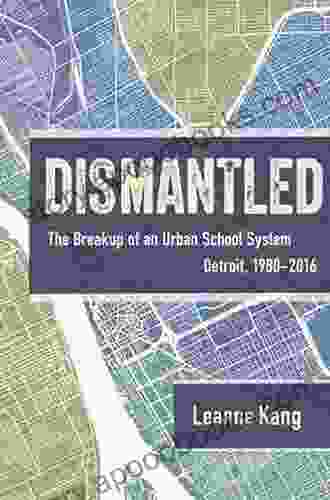Unraveling the Complexities of Urban School System Breakups: A Comprehensive Exploration

In the tapestry of American education, the breakup of urban school systems stands as a topic fraught with complexity and nuance. From the ashes of these disbandments, a kaleidoscope of challenges and opportunities emerges, leaving an indelible mark on the communities they serve. This article takes a deep dive into the labyrinthine world of urban school system breakups, unraveling the intricate threads that bind them together.
4.5 out of 5
| Language | : | English |
| File size | : | 2577 KB |
| Text-to-Speech | : | Enabled |
| Screen Reader | : | Supported |
| Enhanced typesetting | : | Enabled |
| Word Wise | : | Enabled |
| Print length | : | 144 pages |
Causes of Urban School System Breakups
The reasons underpinning urban school system breakups are as diverse as the urban landscapes themselves. Socioeconomic disparities, political strife, and persistent achievement gaps often intertwine to create a combustible mix.
- Socioeconomic Disparities: Urban areas often grapple with stark socioeconomic divisions, with affluent neighborhoods existing alongside pockets of poverty. This disparity can translate into inequitable access to educational resources, exacerbating achievement gaps and fueling dissatisfaction among parents and community members.
- Political Strife: Urban school systems can become entangled in political power struggles, with elected officials and community groups vying for influence. These battles can result in stalemates and gridlock, hindering the implementation of meaningful reforms and ultimately leading to calls for a breakup.
- Persistent Achievement Gaps: Despite decades of efforts to close the achievement gap between students from different backgrounds, it remains a persistent problem in many urban school systems. The inability to address this disparity can erode public confidence in the system and contribute to demands for a breakup.
Consequences of Urban School System Breakups
The consequences of urban school system breakups can be far-reaching and multifaceted.
- Fragmentation of Educational Services: Breakups often result in the creation of multiple smaller school districts, each with its own distinct governance structure, curriculum, and resources. This fragmentation can lead to a lack of coordination and consistency in educational services across the region.
- Increased Administrative Costs: The establishment of multiple school districts requires additional administrative overhead, including new central office staff, board members, and legal counsel. These costs can divert precious resources away from the classroom.
- Equity Concerns: Breakups can exacerbate existing inequities, as new school districts inherit varying levels of resources and capacity. This can lead to further disparities in educational opportunities for students.
- Community Division: School system breakups can deeply divide communities, with residents taking sides and loyalties aligning with particular district boundaries. This division can hinder collaboration and create a sense of mistrust among community members.
Case Studies of Notable Urban School System Breakups
To illuminate the complexities of urban school system breakups, we examine two prominent case studies:
The Breakup of the Kansas City, Missouri School District
In 1989, the Kansas City, Missouri School District underwent a historic breakup, resulting in the creation of eight smaller districts. The breakup was driven by a combination of socioeconomic disparities, political strife, and persistent achievement gaps. The consequences of the breakup included fragmentation of educational services, increased administrative costs, and community division.
The Reunification of the St. Louis, Missouri School District
In contrast to the Kansas City breakup, the St. Louis, Missouri School District embarked on a reunification process in the late 1990s. This process saw the merger of two predominantly African American school districts into a single, unified district. The reunification was motivated by a desire to address historical inequities and improve educational outcomes for all students. The consequences of the reunification included a reduction in fragmentation, increased collaboration, and a renewed sense of community.
Lessons Learned from Urban School System Breakups
A thorough analysis of urban school system breakups yields valuable lessons:
- Breakups should be considered only as a last resort, after all other reform efforts have been exhausted.
- Breakups can have long-term negative consequences, including fragmentation of services, increased costs, and community division.
- Alternative solutions to breakups, such as intra-district autonomy or targeted interventions, should be explored.
- Community involvement and consensus building are crucial for successful breakups or reunifications.
- Long-term monitoring and evaluation are essential to ensure that breakups or reunifications achieve their intended goals.
The breakup of urban school systems is a complex and multifaceted issue with no easy solutions. By understanding the causes, consequences, and lessons learned from notable case studies, we can approach these situations with greater wisdom and foresight. The ultimate goal should be to create equitable, high-quality educational systems that serve all students, regardless of their zip code.
This article provides a comprehensive overview of the topic and serves as a valuable resource for educators, policymakers, and community members alike. By delving into the intricate web of factors that surround urban school system breakups, we can work together to ensure that all students have access to the education they deserve.
4.5 out of 5
| Language | : | English |
| File size | : | 2577 KB |
| Text-to-Speech | : | Enabled |
| Screen Reader | : | Supported |
| Enhanced typesetting | : | Enabled |
| Word Wise | : | Enabled |
| Print length | : | 144 pages |
Do you want to contribute by writing guest posts on this blog?
Please contact us and send us a resume of previous articles that you have written.
 Book
Book Novel
Novel Page
Page Chapter
Chapter Text
Text Story
Story Genre
Genre Reader
Reader Library
Library Paperback
Paperback E-book
E-book Magazine
Magazine Newspaper
Newspaper Paragraph
Paragraph Sentence
Sentence Bookmark
Bookmark Shelf
Shelf Glossary
Glossary Bibliography
Bibliography Foreword
Foreword Preface
Preface Synopsis
Synopsis Annotation
Annotation Footnote
Footnote Manuscript
Manuscript Scroll
Scroll Codex
Codex Tome
Tome Bestseller
Bestseller Classics
Classics Library card
Library card Narrative
Narrative Biography
Biography Autobiography
Autobiography Memoir
Memoir Reference
Reference Encyclopedia
Encyclopedia William R Johnson
William R Johnson Moshe Adler
Moshe Adler Shannon Burke
Shannon Burke Staughton Lynd
Staughton Lynd Winston S Churchill
Winston S Churchill Michael Downes
Michael Downes Tony Roppon
Tony Roppon Laurie Elmquist
Laurie Elmquist William Westney
William Westney Robert Hackford
Robert Hackford Steven M Friedson
Steven M Friedson Mary Mapes
Mary Mapes Sylvain Zelliot
Sylvain Zelliot Manuel Hutchinson Iii
Manuel Hutchinson Iii Patti Medaris Culea
Patti Medaris Culea Paul F Grendler
Paul F Grendler Ledell Walters
Ledell Walters Susan Wiggs
Susan Wiggs Matthew Phillion
Matthew Phillion Marcus E Ethridge
Marcus E Ethridge
Light bulbAdvertise smarter! Our strategic ad space ensures maximum exposure. Reserve your spot today!

 Miguel de CervantesRediscovering Identity and Roots: A Journey Home with Édouard Glissant's...
Miguel de CervantesRediscovering Identity and Roots: A Journey Home with Édouard Glissant's...
 Jeffery BellYesterday Was Weird: A Thrilling Novel That Will Keep You on the Edge of Your...
Jeffery BellYesterday Was Weird: A Thrilling Novel That Will Keep You on the Edge of Your... Lawrence BellFollow ·15.4k
Lawrence BellFollow ·15.4k Geoffrey BlairFollow ·3.9k
Geoffrey BlairFollow ·3.9k Isaiah PowellFollow ·6.2k
Isaiah PowellFollow ·6.2k Gabriel HayesFollow ·14.5k
Gabriel HayesFollow ·14.5k Rodney ParkerFollow ·2.9k
Rodney ParkerFollow ·2.9k Ernest PowellFollow ·7.1k
Ernest PowellFollow ·7.1k Grant HayesFollow ·19.1k
Grant HayesFollow ·19.1k Andrew BellFollow ·3.2k
Andrew BellFollow ·3.2k

 Jorge Luis Borges
Jorge Luis BorgesUnlock Your Inner Musician: The Ultimate Guide to...
Embark on a Musical...

 Carlos Drummond
Carlos DrummondQuick Reference Guide To Percussion Instruments And How...
Unleash your inner rhythm with...

 Roberto Bolaño
Roberto BolañoUnlock Your Guitar Potential: The Ultimate Guitar Mastery...
Are you ready...

 Fred Foster
Fred FosterLooking for Lady Dee: A Punk Rock Mystery
By [Author's Name] Looking for Lady Dee is...

 Jacques Bell
Jacques BellJourney into the Mystical Realm of "Heaven Polly Alice...
In the tapestry of literature, where...

 Julio Ramón Ribeyro
Julio Ramón RibeyroSixty Years of Hits: A Musical Journey Through Time
Music has the...
4.5 out of 5
| Language | : | English |
| File size | : | 2577 KB |
| Text-to-Speech | : | Enabled |
| Screen Reader | : | Supported |
| Enhanced typesetting | : | Enabled |
| Word Wise | : | Enabled |
| Print length | : | 144 pages |








